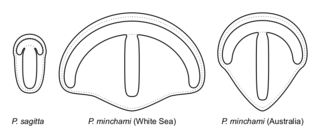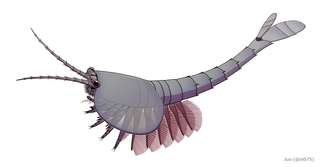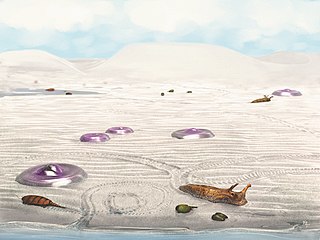Related Research Articles

The Cambrian Period was the first geological period of the Paleozoic Era, and of the Phanerozoic Eon. The Cambrian lasted 53.4 million years from the end of the preceding Ediacaran Period 538.8 million years ago (mya) to the beginning of the Ordovician Period 485.4 mya. Its subdivisions, and its base, are somewhat in flux. The period was established as "Cambrian series" by Adam Sedgwick, who named it after Cambria, the Latin name for 'Cymru' (Wales), where Britain's Cambrian rocks are best exposed. Sedgwick identified the layer as part of his task, along with Roderick Murchison, to subdivide the large "Transition Series", although the two geologists disagreed for a while on the appropriate categorization. The Cambrian is unique in its unusually high proportion of lagerstätte sedimentary deposits, sites of exceptional preservation where "soft" parts of organisms are preserved as well as their more resistant shells. As a result, our understanding of the Cambrian biology surpasses that of some later periods.

The lobopodians, members of the informal group Lobopodia, or the formally erected phylum Lobopoda Cavalier-Smith (1998), are panarthropods with stubby legs called lobopods, a term which may also be used as a common name of this group as well. While the definition of lobopodians may differ between literatures, it usually refers to a group of soft-bodied, worm-like fossil panarthropods such as Aysheaia and Hallucigenia.

Trilobites are extinct marine arthropods that form the class Trilobita. Trilobites form one of the earliest-known groups of arthropods. The first appearance of trilobites in the fossil record defines the base of the Atdabanian stage of the Early Cambrian period and they flourished throughout the lower Paleozoic before slipping into a long decline, when, during the Devonian, all trilobite orders except the Proetida died out. The last extant trilobites finally disappeared in the mass extinction at the end of the Permian about 252 million years ago. Trilobites were among the most successful of all early animals, existing in oceans for almost 270 million years, with over 20,000 species having been described.

Opabinia regalis is an extinct, stem group arthropod found in the Middle Cambrian Burgess Shale Lagerstätte of British Columbia. Opabinia was a soft-bodied animal, measuring up to 7 cm in body length, and its segmented trunk had flaps along the sides and a fan-shaped tail. The head shows unusual features: five eyes, a mouth under the head and facing backwards, and a clawed proboscis that probably passed food to the mouth. Opabinia probably lived on the seafloor, using the proboscis to seek out small, soft food. Fewer than twenty good specimens have been described; 3 specimens of Opabinia are known from the Greater Phyllopod bed, where they constitute less than 0.1% of the community.

Sidneyia is an extinct arthropod known from fossils found from the Early Cambrian-age Maotianshan Shales to the Mid Cambrian Burgess Shale formation of British Columbia. 144 specimens of Sidneyia are known from the Greater Phyllopod bed, where they comprise 0.27% of the community.

The Emu Bay Shale is a geological formation in Emu Bay, South Australia, containing a major Konservat-Lagerstätte. It is one of two in the world containing Redlichiidan trilobites. The Emu Bay Shale is dated as Cambrian Series 2, Stage 4, correlated with the upper Botomian Stage of the Lower Cambrian.

Parvancorina is a genus of shield-shaped bilaterally symmetrical fossil animal that lived in the late Ediacaran seafloor. It has some superficial similarities with the Cambrian trilobite-like arthropods.
The Kaili Formation is a stratigraphic formation which was deposited during the Lower and Middle Cambrian. The formation is approximately 200 metres (660 ft) thick and was named after the city Kaili in the Guizhou province of southwest China.

Waptia fieldensis is an extinct species of arthropod from the Middle Cambrian Burgess Shale Lagerstätte of Canada. It grew to a length of about 8 cm (3 in) and resembled modern shrimp in both morphology and habit. It had a large bivalved carapace and a segmented body terminating into a pair of tail flaps. It was an active swimmer, feeding on organic particles it gathered from the seafloor substrate. It is also one of the oldest animals with direct evidence of brood care.

Aglaspidida is an extinct order of aquatic arthropods that were once regarded as primitive chelicerates. However, anatomical comparisons demonstrate that the aglaspidids cannot be accommodated within the chelicerates, and that they lie instead within the Artiopoda, thus placing them closer to the trilobites. Aglaspidida contains the subgroups Aglaspididae and Tremaglaspididae, which are distinguished by the presence of acute/spinose genal angles and a long spiniform tailspine in the Aglaspididae.
A number of assemblages bear fossil assemblages similar in character to that of the Burgess Shale. While many are also preserved in a similar fashion to the Burgess Shale, the term "Burgess Shale-type fauna" covers assemblages based on taxonomic criteria only.
Dongshanocaris is genus of Cambrian arthropod known for being a member of the Chengjiang biota, containing the single species D. foliiformis. It was described by Hou and Bergstrom in 1999. In 2013 Oxford University fellow David Legg described it as "too poorly preserved to verify their identity as a valid taxa"

Isoxys is a genus of extinct, pelagic bivalved Cambrian arthropod; the various species may have been roam-swimming predators. It had a pair of large spherical eyes, and two large appendages It is possible that these appendages are homologous to the great appendages of radiodonts and megacheirans.
Pseudoiulia is a genus of Cambrian arthropod known for being a member of the Chengjiang biota, containing the single species P. cambriensis. It is considered poorly known, but has been associated with the megacheira.
The Pioche Shale is an Early to Middle Cambrian Burgess shale-type Lagerstätte in Nevada. It spans the Early–Middle Cambrian boundary; fossils from the Early Cambrian are preserved in botryoidal hematite, whereas those from the Middle Cambrian are preserved in the more familiar carbon films, and very reminiscent of the Chengjiang County preservation.
The fossils of the Burgess Shale, like the Burgess Shale itself, formed around 505 million years ago in the Mid Cambrian period. They were discovered in Canada in 1886, and Charles Doolittle Walcott collected over 65,000 specimens in a series of field trips up to the alpine site from 1909 to 1924. After a period of neglect from the 1930s to the early 1960s, new excavations and re-examinations of Walcott's collection continue to reveal new species, and statistical analysis suggests that additional discoveries will continue for the foreseeable future. Stephen Jay Gould's book Wonderful Life describes the history of discovery up to the early 1980s, although his analysis of the implications for evolution has been contested.

Blackberry Hill is a Konservat-Lagerstätte of Cambrian age located within the Elk Mound Group in Marathon County, Wisconsin. It is found in a series of quarries and outcrops that are notable for their large concentration of exceptionally preserved trace fossils in Cambrian tidal flats. One quarry in particular also has the distinction of preserving some of the first land animals. These are preserved as three-dimensional casts, which is unusual for Cambrian animals that are only lightly biomineralized. Additionally, Blackberry Hill is the first occurrence recognized to include Cambrian mass strandings of scyphozoans (jellyfish).

Paleontology in Wisconsin refers to paleontological research occurring within or conducted by people from the U.S. state of Wisconsin. The state has fossils from the Precambrian, much of the Paleozoic, and the later part of the Cenozoic. Most of the Paleozoic rocks are marine in origin. Because of the thick blanket of Pleistocene glacial sediment that covers the rock strata in most of the state, Wisconsin’s fossil record is relatively sparse. In spite of this, certain Wisconsin paleontological occurrences provide exceptional insights concerning the history and diversity of life on Earth.

Strabops is a genus of strabopid, an extinct group of arthropods. Strabops is known from a single specimen from the Late Cambrian of the Potosi Dolomite, Missouri, collected by a former professor, Arthur Thacher. It is classified in the family Strabopidae of the monotypic order Strabopida, a group closely related to the aglaspidids with uncertain affinities. The generic name is composed by the Ancient Greek words στραβός, meaning "squinting", and ὄψῐς, meaning "face".

Paleomerus is a genus of strabopid, a group of extinct arthropods. It has been found in deposits from the Cambrian period. It is classified in the family Strabopidae of the monotypic order Strabopida. It contains two species, P. hamiltoni from Sweden and P. makowskii from Poland. The generic name is composed by the Ancient Greek words παλαιός (palaiós), meaning "ancient", and μέρος (méros), meaning "part".
References
- ↑ Rudy Lerosey-Aubril (2014). "Notchia weugi gen. et sp. nov.: A new short-headed arthropod from the Weeks Formation Konservat-Lagerstatte (Cambrian; Utah)". Geological Magazine. 152 (2): 351–357. doi:10.1017/S0016756814000375. S2CID 83671216.